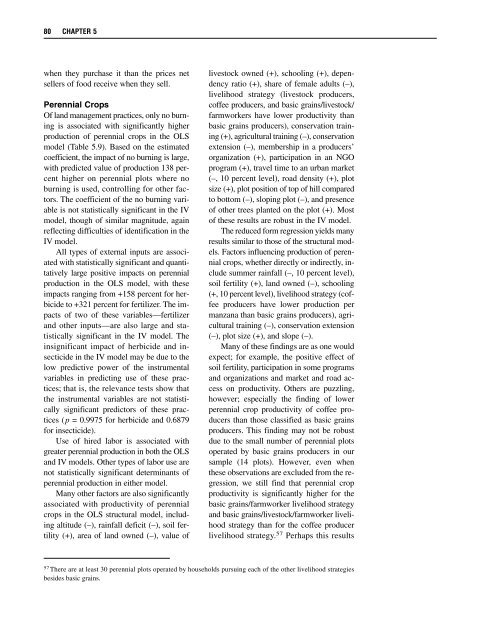Rural Development Policies and Sustainable Land Use in the ...
Rural Development Policies and Sustainable Land Use in the ...
Rural Development Policies and Sustainable Land Use in the ...
You also want an ePaper? Increase the reach of your titles
YUMPU automatically turns print PDFs into web optimized ePapers that Google loves.
80 CHAPTER 5<br />
when <strong>the</strong>y purchase it than <strong>the</strong> prices net<br />
sellers of food receive when <strong>the</strong>y sell.<br />
Perennial Crops<br />
Of l<strong>and</strong> management practices, only no burn<strong>in</strong>g<br />
is associated with significantly higher<br />
production of perennial crops <strong>in</strong> <strong>the</strong> OLS<br />
model (Table 5.9). Based on <strong>the</strong> estimated<br />
coefficient, <strong>the</strong> impact of no burn<strong>in</strong>g is large,<br />
with predicted value of production 138 percent<br />
higher on perennial plots where no<br />
burn<strong>in</strong>g is used, controll<strong>in</strong>g for o<strong>the</strong>r factors.<br />
The coefficient of <strong>the</strong> no burn<strong>in</strong>g variable<br />
is not statistically significant <strong>in</strong> <strong>the</strong> IV<br />
model, though of similar magnitude, aga<strong>in</strong><br />
reflect<strong>in</strong>g difficulties of identification <strong>in</strong> <strong>the</strong><br />
IV model.<br />
All types of external <strong>in</strong>puts are associated<br />
with statistically significant <strong>and</strong> quantitatively<br />
large positive impacts on perennial<br />
production <strong>in</strong> <strong>the</strong> OLS model, with <strong>the</strong>se<br />
impacts rang<strong>in</strong>g from +158 percent for herbicide<br />
to +321 percent for fertilizer. The impacts<br />
of two of <strong>the</strong>se variables—fertilizer<br />
<strong>and</strong> o<strong>the</strong>r <strong>in</strong>puts—are also large <strong>and</strong> statistically<br />
significant <strong>in</strong> <strong>the</strong> IV model. The<br />
<strong>in</strong>significant impact of herbicide <strong>and</strong> <strong>in</strong>secticide<br />
<strong>in</strong> <strong>the</strong> IV model may be due to <strong>the</strong><br />
low predictive power of <strong>the</strong> <strong>in</strong>strumental<br />
variables <strong>in</strong> predict<strong>in</strong>g use of <strong>the</strong>se practices;<br />
that is, <strong>the</strong> relevance tests show that<br />
<strong>the</strong> <strong>in</strong>strumental variables are not statistically<br />
significant predictors of <strong>the</strong>se practices<br />
(p = 0.9975 for herbicide <strong>and</strong> 0.6879<br />
for <strong>in</strong>secticide).<br />
<strong>Use</strong> of hired labor is associated with<br />
greater perennial production <strong>in</strong> both <strong>the</strong> OLS<br />
<strong>and</strong> IV models. O<strong>the</strong>r types of labor use are<br />
not statistically significant determ<strong>in</strong>ants of<br />
perennial production <strong>in</strong> ei<strong>the</strong>r model.<br />
Many o<strong>the</strong>r factors are also significantly<br />
associated with productivity of perennial<br />
crops <strong>in</strong> <strong>the</strong> OLS structural model, <strong>in</strong>clud<strong>in</strong>g<br />
altitude (–), ra<strong>in</strong>fall deficit (–), soil fertility<br />
(+), area of l<strong>and</strong> owned (–), value of<br />
livestock owned (+), school<strong>in</strong>g (+), dependency<br />
ratio (+), share of female adults (–),<br />
livelihood strategy (livestock producers,<br />
coffee producers, <strong>and</strong> basic gra<strong>in</strong>s/livestock/<br />
farmworkers have lower productivity than<br />
basic gra<strong>in</strong>s producers), conservation tra<strong>in</strong><strong>in</strong>g<br />
(+), agricultural tra<strong>in</strong><strong>in</strong>g (–), conservation<br />
extension (–), membership <strong>in</strong> a producers’<br />
organization (+), participation <strong>in</strong> an NGO<br />
program (+), travel time to an urban market<br />
(–, 10 percent level), road density (+), plot<br />
size (+), plot position of top of hill compared<br />
to bottom (–), slop<strong>in</strong>g plot (–), <strong>and</strong> presence<br />
of o<strong>the</strong>r trees planted on <strong>the</strong> plot (+). Most<br />
of <strong>the</strong>se results are robust <strong>in</strong> <strong>the</strong> IV model.<br />
The reduced form regression yields many<br />
results similar to those of <strong>the</strong> structural models.<br />
Factors <strong>in</strong>fluenc<strong>in</strong>g production of perennial<br />
crops, whe<strong>the</strong>r directly or <strong>in</strong>directly, <strong>in</strong>clude<br />
summer ra<strong>in</strong>fall (–, 10 percent level),<br />
soil fertility (+), l<strong>and</strong> owned (–), school<strong>in</strong>g<br />
(+, 10 percent level), livelihood strategy (coffee<br />
producers have lower production per<br />
manzana than basic gra<strong>in</strong>s producers), agricultural<br />
tra<strong>in</strong><strong>in</strong>g (–), conservation extension<br />
(–), plot size (+), <strong>and</strong> slope (–).<br />
Many of <strong>the</strong>se f<strong>in</strong>d<strong>in</strong>gs are as one would<br />
expect; for example, <strong>the</strong> positive effect of<br />
soil fertility, participation <strong>in</strong> some programs<br />
<strong>and</strong> organizations <strong>and</strong> market <strong>and</strong> road access<br />
on productivity. O<strong>the</strong>rs are puzzl<strong>in</strong>g,<br />
however; especially <strong>the</strong> f<strong>in</strong>d<strong>in</strong>g of lower<br />
perennial crop productivity of coffee producers<br />
than those classified as basic gra<strong>in</strong>s<br />
producers. This f<strong>in</strong>d<strong>in</strong>g may not be robust<br />
due to <strong>the</strong> small number of perennial plots<br />
operated by basic gra<strong>in</strong>s producers <strong>in</strong> our<br />
sample (14 plots). However, even when<br />
<strong>the</strong>se observations are excluded from <strong>the</strong> regression,<br />
we still f<strong>in</strong>d that perennial crop<br />
productivity is significantly higher for <strong>the</strong><br />
basic gra<strong>in</strong>s/farmworker livelihood strategy<br />
<strong>and</strong> basic gra<strong>in</strong>s/livestock/farmworker livelihood<br />
strategy than for <strong>the</strong> coffee producer<br />
livelihood strategy. 57 Perhaps this results<br />
57<br />
There are at least 30 perennial plots operated by households pursu<strong>in</strong>g each of <strong>the</strong> o<strong>the</strong>r livelihood strategies<br />
besides basic gra<strong>in</strong>s.
















